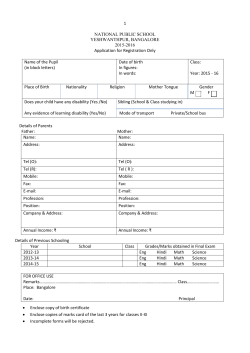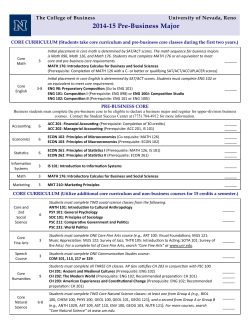
University of Misan College of Engineering Dep. of Electrical First
University of Misan College of Engineering Dep. of Electrical First Stage Fundamental of Elect. Eng. Dr. Malik CHAPTER TWO 2. Basic Laws : 2.1. Ohm's Law : Ohm’s law states that the voltage (V) across a resistor is directly proportional to the current (I) flowing through the resistor. That is : Where (R) is the resistance which denotes the ability of an element to resist the flow of an electric current. It is measured in ohms (Ω ) . The resistance of any material with a uniform cross-sectional area (A) depends on (A) and its length ( L), as shown in figure below. In mathematical form, where (ρ) is known as the resistivity of the material in ( Ωm) . Good conductors, such as copper and aluminum, have low resistivities, while insulators, such as mica and paper, have high resistivities. Ohm’s law states that the voltage v across a resistor is directly proportional to the current i flowing through the resistor. University of Misan College of Engineering Dep. of Electrical First Stage Fundamental of Elect. Eng. Dr. Malik The resistance R of an element denotes its ability to resist the flow of electric current; it is measured in ohms (Ω). University of Misan College of Engineering Dep. of Electrical First Stage Fundamental of Elect. Eng. Dr. Malik infinity. University of Misan College of Engineering Dep. of Electrical First Stage Fundamental of Elect. Eng. Dr. Malik The two common types of fixed resistors (wirewound and composition) are shown in Fig1. . Fig. 1Fixed resistors: (a) wirewound type, (b) carbon film type. (Courtesy of Tech America.) The symbol for a variable resistor is shown in Fig. 2 Fig.2 University of Misan College of Engineering Dep. of Electrical First Stage Fundamental of Elect. Eng. Dr. Malik 2 .2Conductance : Ex1: In the circuit shown, calculate the current, the conductance, and the power. Sol. University of Misan College of Engineering Dep. of Electrical First Stage Fundamental of Elect. Eng. Dr. Malik Ex. 2 A voltage source of 20 sin πt V is connected across a 5-k_ resistor. Find the current through the resistor and the power dissipated. Sol. Home work 1-For the circuit shown in Fig. , calculate the voltage v, the conductance G, and the power p. 2- A resistor absorbs an instantaneous power of 20 cos2 t mW when connected to a voltage source v = 10 cos t V. Find i and R. 2,3 Branches, Nodes, and Loops : A branch represents a single element such as a voltage source or a resistor. In other words, a branch represents any two-terminal element. The circuit in Fig. has five branches, namely, the 10-V voltage source, the 2-A current source, and the three resistors. A node is the point of connection between two or more branches. A node is usually indicated by a dot in a circuit. If a short circuit (a connecting wire) connects two nodes, the two nodes constitute a single node. The circuit in Fig. has three nodes a, b, and c. University of Misan College of Engineering Dep. of Electrical First Stage Fundamental of Elect. Eng. Dr. Malik A loop is any closed path in a circuit. For example, the closed path abca containing the 2-_ resistor in Fig. is a loop. Another loop is the closed path bcb containing the 3-_ resistor and the current source. Although one can identify six loops in Fig. , only three of them are independent. 2.4 Kirchoff's laws : Kirchhoff’s Current Law (KCL): It states that the algebraic sum of currents entering a node (or a closed boundary) is zero, or : The sum of the currents entering a node is equal to the sum of the currents leaving the node. Mathematically : Where (Imi ) are the currents entering the node, while ( Ino) are the currents leaving the node. Kirchhoff’s Voltage Law (KVL): It states that the algebraic sum of all voltages around a closed path(or loop) is zero. Mathematically, it is expressed as : Where (M) is the number of voltages in the loop, and ( Vm) is the (math ) voltage. University of Misan College of Engineering Dep. of Electrical First Stage Fundamental of Elect. Eng. Dr. Malik Ex. For the circuit in Fig. , find voltages v1 and v2. Sol. University of Misan College of Engineering Dep. of Electrical First Stage Fundamental of Elect. Eng. Dr. Malik Ex. Find the currents and voltages in the circuit shown in Fig. 2.27(a). University of Misan College of Engineering Dep. of Electrical First Stage Fundamental of Elect. Eng. Dr. Malik University of Misan College of Engineering Dep. of Electrical First Stage Fundamental of Elect. Eng. Dr. Malik 2.5 SERIES RESISTORS AND VOLTAGE DIVISION The need to combine resistors in series or in parallel occurs so frequently that it warrants special attention. The process of combining the resistors is facilitated by combining two of them at a time. With this in mind, consider the single-loop circuit of Fig. . The two resistors are in series, since the same current i flows in both of them. Applying Ohm’s law to each of the resistors, we obtain v1 = iR1, v2 = iR2 If we apply KVL to the loop (moving in the clockwise direction), we have −v + v1 + v2 = 0 University of Misan College of Engineering Dep. of Electrical First Stage Fundamental of Elect. Eng. Dr. Malik The equivalent resistance of any number of resistors connected in series is the sum of the individual resistances. 2.6 PARALLEL RESISTORS AND CURRENT DIVISION Consider the circuit in Fig., where two resistors are connected in parallel and therefore have the same voltage across them. From Ohm’s law, v = i1R1 = i2R2 University of Misan College of Engineering Dep. of Electrical First Stage Fundamental of Elect. Eng. Dr. Malik University of Misan College of Engineering Dep. of Electrical First Stage Fundamental of Elect. Eng. Dr. Malik 2.7 WYE-DELTA TRANSFORMATIONS Delta to Wye Conversion Each resistor in the Y network is the product of the resistors in the two adjacent " branches, divided by the sum of the three " resistors. University of Misan College of Engineering Dep. of Electrical First Stage Fundamental of Elect. Eng. Dr. Malik Wye to Delta Conversion Each resistor in the " network is the sum of all possible products of Y resistorstaken two at a time, divided by the opposite Y resistor. University of Misan College of Engineering Dep. of Electrical First Stage Fundamental of Elect. Eng. Dr. Malik University of Misan College of Engineering Dep. of Electrical First Stage Fundamental of Elect. Eng. Dr. Malik University of Misan College of Engineering Dep. of Electrical First Stage Fundamental of Elect. Eng. Dr. Malik University of Misan College of Engineering Dep. of Electrical First Stage Fundamental of Elect. Eng. Dr. Malik 2.8APPLICATIONS Resistors are often used to model devices that convert electrical energy into heat or other forms of energy. Such devices include conducting wire, lightbulbs, electric heaters, stoves, ovens, and loudspeakers University of Misan College of Engineering Dep. of Electrical First Stage Fundamental of Elect. Eng. Dr. Malik University of Misan College of Engineering Dep. of Electrical First Stage Fundamental of Elect. Eng. Dr. Malik University of Misan College of Engineering Dep. of Electrical First Stage Fundamental of Elect. Eng. Dr. Malik
© Copyright 2025









